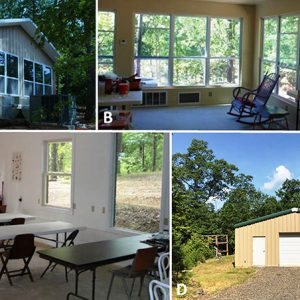calsfoundation@cals.org
Ouachita Mountains Biological Station
The Ouachita Mountains Biological Station (OMBS) began serving the needs of colleges and universities as a research and education center in 1962. The OMBS was the vision of husband-and-wife team Dr. Richard K. (Dick) Speairs Jr. (1920‒2004) and Dr. Betty McKnight Speairs (1925‒2018), formerly of Louisiana State University and Centenary College (both in Shreveport, Louisiana), respectively. Together they founded the Speairs Charitable Foundation for the perpetual support of the OMBS. The station hosts collegiate groups, graduate students, faculty, and researchers for any aspect of field research and biological education. It is available at any time during the year by reservation only.
The OMBS is located in the central part of the Ouachita Mountains of Arkansas, between the towns of Mena (Polk County) and Glenwood (Montgomery County) on Highway 8. Local subdivisions of the Ouachita Mountains in this area include the Caddo, Cossatot, and Missouri mountains. The 242-hectare (600-acre) OMBS lies within the Caddo Range, between the drainages of the Ouachita and Little Missouri rivers. Individual mountain ridges within the Caddo Range run east to west; the OMBS property straddles two of these ridges: Fork Mountain and Rattlesnake Mountain.
Geological units in the densely forested area include the ridge-forming Big Fork Chert (Ordovician) and Arkansas Novaculite (Devonian‒Mississippian) and several interlayered, valley-forming softer strata, such as the Polk Creek Shale, Missouri Mountain Shale, and Stanley Shale rock units, all Paleozoic in age.
Topographically, the area consists of steep, rocky mountain slopes forming narrow ridges running east-west, separated by narrow floodplains. Soils of the area are developed in mixed material from alternate beds of shale, sandstone, and novaculite; are dry to droughty; and have moderate erosion potential. To date, the site comprises a 242-hectare (600-acre) natural area with elevations ranging from approximately 369 to 622 m (1,210 to 2,040 ft.).
There are a number of facilities for use by visitors, including: (1) Nuthatch, encompassing 100.7 square meters (1,084 square feet) with sleeping facilities for ten, a combination laboratory/kitchenette, two bathrooms and shower, and heat/AC; (2) Bufo, a small residence; (3) Kingfisher, a pavilion (with electricity and water) for camping or work space; (4) Phoebe, an educational building with workspace for twenty-four or more, with excellent lighting, many windows, bathroom, shower, washer/dryer, heat/AC, and table; (5) Neotoma, a one-bedroom cabin with one single bed and two bunk beds, windows, and electricity but no water; (6) Bear, the home of the resident manager; and (6) Dogwood, the office and library, with heat/AC, as well as the site of Big Fork station of the U.S. Weather Bureau.
The OMBS buildings were constructed in rustic form starting in the 1960s and 1970s. Back then, student groups would camp and make some use of the buildings and a small bunkhouse, but renovations during the 2010s added roofing and metal siding to the principal buildings, including the main building (Nuthatch), which was extended to form a large mess hall room and full kitchen, in addition to new bunk beds. The most recent addition was the shop, a large metal building for storing all-terrain vehicles and tools in one half, and for small project construction in the other half. Construction of the shop building allowed the Phoebe education building to be used as a full lab space, a welcome improvement for groups needing multiple tables, microscopes, and space for field equipment.
Woody plant biota of the area is a mixture of pine-hardwood forest with the following dominant tree species: shortleaf pine (Pinus echinata), southern red oak (Q. falcata), blackjack oak (Q. marilandica), post oak (Quercus stellata), black oak (Q. velutina), and sweetgum (Liquidambar styraciflua), with understory consisting of dogwood (Cornus spp.), downy serviceberry (Amelanchier arborea), American hornbeam (Carpinus caroliniana), eastern hophornbeam (Ostrya virginiana), and winged elm (Ulmus alata). Vascular flora is equally diverse and includes a number of species.
Invertebrates abound at the OMBS, including a great diversity of insects. Vertebrate biota of the OMBS includes several species of fish, amphibians, reptiles, birds, and mammals. Within an 80 km (50 mi.) radius, several endemic species of salamanders may be found, including the Caddo Mountain salamander (Plethodon caddoensis) and Rich Mountain salamander (P. ouachitae). Several venomous snakes occur at the OMBS, including western cottonmouth (Agkistrodon piscivorus leucostoma), southern copperhead (A. contortrix contortrix), and timber rattlesnake (Crotalus horridus). There are about 113 species of resident and migratory birds at the OMBS.
Subjects of recent and current studies for visitors to the OMBS include identifying species of oak (Quercus) trees; discovering the roosting behavior of the eastern small-footed bat (Myotis leibii); tabulating the distribution of lichens; describing parasites in fish and other vertebrates; and studying genetics of such diverse animal groups as pine trees (Pinus) and salamanders (Desmognathus and Plethodon spp.).
For additional information:
Byrd, Tom. “Bev Edwards—Steward of the Land, Friend of Science: Local Man Devotes Himself to Preserving Land and Supports the Development of Ouachita Mountains Biological Station.” Mena Star, August 17, 2018. Online at http://www.menastar.com/news/article_042fcae8-a241-11e8-90dc-4f2b14ca8abf.html (accessed February 25, 2021).
Hardy, Laurence M., compiler. “The Biodiversity of the Ouachita Mountains Biological Station (Potential and Verified).” Ouachita Mountains Biological Station. http://www.theombs.org/OMBSBiotaJan2019.pdf (accessed February 25, 2021).
MacRoberts, Brad R., Michael H. MacRoberts, and Travis D. Marsico. “Preliminary Survey of the Vascular Flora of the Ouachita Mountains Biological Station, Polk County, Arkansas.” Bulletin of the Museum of Life Sciences, No. 13, Louisiana State University in Shreveport, 2005.
Ouachita Mountains Biological Station. http://www.theombs.org/ (accessed February 25, 2021).
Speairs, Richard K., Jr. “Ouachita Biological Station.” Proceedings of the Arkansas Academy of Science 30 (1976): 83. Online at https://scholarworks.uark.edu/cgi/viewcontent.cgi?article=2843&context=jaas (accessed February 25, 2021).
Chris T. McAllister
Eastern Oklahoma State College
Jeff Pittman
Ouachita Mountains Biological Station
 Divergent Prosperity and the Arc of Reform, 1968–2022
Divergent Prosperity and the Arc of Reform, 1968–2022 Science and Technology
Science and Technology Ouachita Mountains Biological Station
Ouachita Mountains Biological Station  Ouachita Mountains Biological Station
Ouachita Mountains Biological Station 



Comments
No comments on this entry yet.